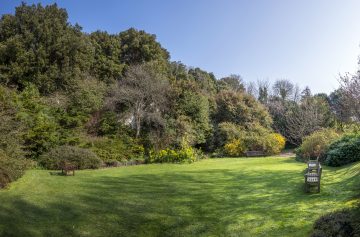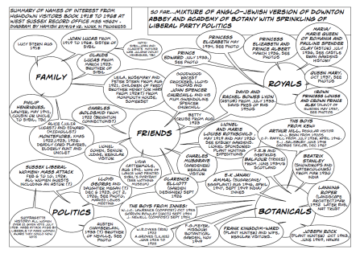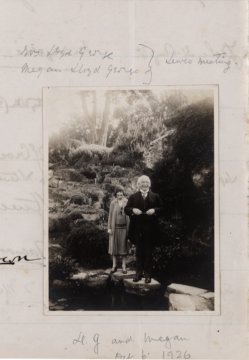During the autumn of 2019 I spent many “wow” moments in the West Sussex Record Office (WSRO) reading room discovering forgotten stories about Highdown Gardens and its original owners. Did you know that Highdown Gardens started because of a tennis court in 1909? New plants were purchased by Sir Frederick Stern at first to hide the chalk pit glare from his tennis court. Experts said nothing could grow on chalk. By 1910 Stern became obsessed and built his first rockery. When Sybil Lucas married Stern in 1919, she joined in the horticultural experiment.

The Highdown Chalk Pit – in 1909 this was the Highdown tennis court.
(Photograph taken April 2019 by Steve Speller.)
Panels and campers
When I started this job, supported by the National Heritage Lottery Fund, I was struggling to get my head around specialist horticulture and botanical Latin names. I am not a gardener. I was asked to produce text and images for at least 7 exhibition paneIs to be displayed in the new Highdown Visitor Centre. I was expecting Frederick Stern’s book ‘A Chalk Garden’ to offer clues – but I found it difficult to read. In fact, my first web searches kept on steering me to an old Jewish Youth Club that used to camp near the Miller’s Tomb on Highdown Hill, I could not work out their connection with the Sterns.
The Visitors

Mapping out the names from the Highdown Visitors Book Sept 2019, using Comic Life software.
(copyright © H.MacGillivray)
Then I discovered the Highdown Visitors Book at the WSRO. This is an amazing time machine with signatures, poems and even photos from 1918 to 1968. This shows the waves of visitors that game to Highdown including: Jewish aristocrats (Lionel Rothschild, Lucy Stern), plant hunters (Frank and Jean Kingdon-Ward), Royals (Prince Edward, Prince Albert and their mother Queen Mary), politicians (Lloyd George) and scientists (E.K. Janaki Ammal). Unlike other Visitors Books I have seen, the Sterns also pasted in photos of some of their VIP visitors. The image of a giggling Lloyd George and daughter Megan (WSRO Add Mss 45624) marooned near the Lime Kiln is my favourite. See my ‘bubble’ diagram of some of the visitor names.

Lloyd George and Megan – 6th October 1926
(WSRO Add Mss 45624)
Letters and photos
The Visitors Book was the key to the project as it was proof that the Sterns were part of the last generation of Anglo-Jewish aristocrats who were obsessed with big game hunting, horses, politics, philanthropy, military life, science and of course gardens. With the signatures I managed to cross reference Stern’s letters in other archives such as at the John Innes Centre in Norwich and the Kew Botanical Gardens archive. There was a surprise on my last visit to Worthing Library when Martin Hayes remembered a forgotten Highdown photo album in the basement of Worthing Library. This contains a memorable image of Stern grinning through his psychedelic eremurus or foxtails lilies.

Frederick Stern peeking behind foxtails, 1930s
(WSRO Acc 19642)
Lockdown
Just as I was starting to draft text for the Visitor Centre panels the first Lockdown was announced. I was very lucky that Highdown Gardens and the Lottery extended my contract during those strange times. There were also plans for a new Highdown Gardens website which I knew would be image hungry. To my surprise, Jennifer Mason and Claire Snoad were able to go into the WSRO archive for limited periods. With my knowledge of the WSRO material I asked Jennifer if it was possible to digitize key photographs and later the entire Highdown Visitors Book. This the WSRO team did with efficiency and speed. We now have images from the WSRO Highdown collection on: external signage at Highdown, inside the new Visitor Centre and soon in a unique historical section in the new website. Some of the VIP photos from the Highdown Visitors Book are also being used for guided tour training for volunteers.

Interior of new Highdown Visitors Centre.
(Photograph taken April 2021 by H. MacGillivray)
Oxford
And what of the Jewish campers? After talking to local volunteers and an international phone call to the BBC’s Jon Sopel last summer I discovered that the Sterns allowed the Oxford and St. George’s Jewish youth clubs to camp every summer on their fields for 50 years, another forgotten part of the Sterns philanthropy work in London and Goring. With all this new evidence I approached the University of Oxford’s Jewish Country Houses team who are advising the National Trust on raising awareness of former Jewish properties. We are now expecting a group of historians to visit Highdown this summer.
This has been a remarkable two-year research journey for me, and it would never have developed were it not for the support of the WSRO team.